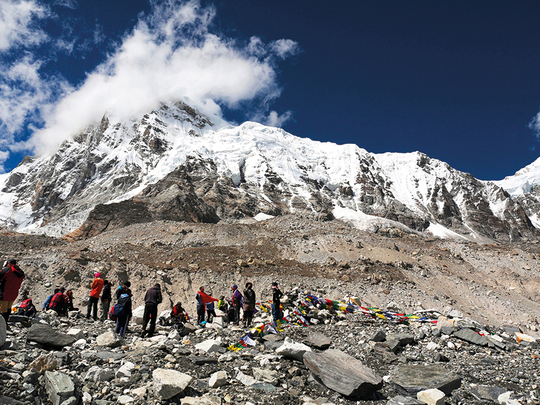
KATHMANDU, Nepal: As climbers begin to reach the summit of Mount Everest, some veterans are avoiding the Nepali side of the world’s highest peak because melting ice and crowds have made its famed Khumbu Icefall too dangerous.
Not far from the safety of the Everest Base Camp, the icefall is a climber’s first real test: a treacherous 760-yard stretch of ice with shifting crevasses that has claimed the lives of about a quarter of those who have died on the Nepali side of the mountain, including 16 Nepali guides in 2014.
Several veteran climbers and well-respected Western climbing companies have moved their expeditions to the northern side of the mountain in Tibet in recent years, saying rising temperatures and inexperienced climbers have made the icefall more vulnerable. Research by the International Center for Integrated Mountain Development shows that the Khumbu glacier is retreating at an average of 65 feet per year, raising the risk of avalanche.
“The icefall is obviously a dangerous place to be, especially later on in the season and with increased temperatures experienced in the Himalayas due to climate change,” Phil Crampton of the climbing company Altitude Junkies told the Everest blogger Alan Arnette earlier this year.
Nepali mountain guides — known as Sherpa — make the first trek through the icefall each year, installing ropes and ladders and carrying gear before the first climbers begin travelling through the icefall on acclimatising runs in April and May. In past years, climbers would have to navigate the icefall two to three times, but now many have cut back, turning to other safer peaks with similar heights for their early training.
This year, the “icefall doctors” — as the Sherpa are called — say that they’ve constructed a safe passageway.
“There are fewer ladders compared to previous years and hardly any complex features to climb and cross,” said Ang Sarki Sherpa.
Still, many veterans are unconvinced.
“Although guides are calling it an incredibly safe route this year, multiple Sherpa have been injured (including one flown to Kathmandu with serious injuries), and there have been countless close calls for clients, guides and Sherpa,” said mountaineer Adrian Ballinger, who is leading an expedition on the Tibetan side of the mountain this year due to safety concerns. “Getting lucky (so far) does not mean the route is any safer this year.”
Ballinger and others have suggested that a helicopter be used to ferry climbers and supplies to the first camp on the mountain, Camp 1, to improve safety, as is done on other peaks such as Mount Cook in New Zealand.
A sharp increase in the number of “hobby climbers” aspiring to climb Everest and local companies catering to their comfort at cheaper cost than Western firms is adding to overcrowding woes.
“The risks are higher when 99 per cent of climbers are going up as tourists,” said Reinhold Messner, an Italian climber who was the first to ascend Mount Everest without supplementary oxygen. “Mount Everest has become a trekking route, not a place for alpinism.”
Since 2013, the government of Nepal has been issuing about 300 foreign permits every year, which means that, with guides and porters, the slopes of Everest are crowded with about 800 people every year. Last year, Nepali authorities awarded a record-high 375 climbing permits — the most since 1953. The number is dropping to 347 this season.
Although attempts to conquer Everest from the Tibetan side began in 1924, a Chinese team made the first summit on May 25, 1960, and the mountain was closed to foreign climbers from 1950 until 1980. According to the Himalayan Database, a record of expeditions in the Himalayas since 1903, out of 8,306 Everest summits so far, 5,280 have happened from Nepal and 3,026 from Tibet.
Climbers say that China seems committed to avoiding the mistakes made by the Nepal government by issuing too many permits and increasing traffic. According to reports, China issued permits to only 22 Chinese nationals this year, out of the total 180 permits issued, in a bid to control traffic. The Chinese are also trying to boost their domestic tourism with a new mountaineering center in Tingri.
Nepal Mountaineering Association President Santa Bir Lama said climbing Everest can never be risk-free, no matter the side of the ascent, and that those moving to Tibet miss the chance of working with Nepal’s famous Sherpa as well as — in his view — a more satisfying climb.
“From what I understand, people are opting for the north side as it is easier and saves time and money,” Lama said.
— Washington Post












